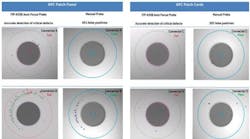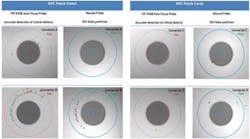Fiber-optic technicians: How confident are you about your connector cleanliness?
By Francis Audet, Vincent Racine, and Gwennaël Amice, EXFO, Inc. -- At the turn of the millennium, fiber inspection was performed with a microscope. This required technicians to stick their eye on a potentially live fiber, which meant risking personal injury every time they had to assess fiber endface quality.
In mid-2005, the eye care community breathed a sigh of relief when the first fiber inspection probes made their way to the market. These probes were able to display an image of the endface on an LCD rather than directly on a tech’s retina. However, this image had to be interpreted. What constituted a defect or contaminant had to be based on user knowledge and gut instinct; depending on the quality of the focus, image centering, and several other parameters, there was always a chance of misinterpretation.
Related product:Fiber inspection, analysis system documents connector cleanliness
By 2010, the first intelligent analysis software for fiber inspection, which was based on the IEC standard, had arrived. The software automatically detected and analyzed any defect, highlighted it on the display screen, and gave an overall pass-fail status, thereby removing the burden of interpretation and human error from the equation. Or did it?
Regardless of the power of the on-board intelligence, poor focus and poor image capture will lead to errors. More often than not, an out- of-focus speck, scratch, or trace will simply not appear on the screen. The intelligent software will give the connector a thumbs up, when in reality it should not have. This is what is referred to as a “false positive.” As the saying goes, garbage in, garbage out.
The figure below compares manual centering and focusing to automatic centering and focusing. The methodology involved inspecting the connector, cleaning it, and inspecting it again (with the manual focus probe) until a pass was obtained. The same port was then inspected with an automated unit.

